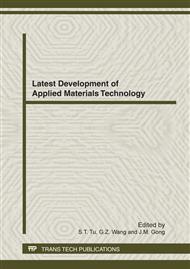[1]
M. Long,H. J. Rack, Titanium alloys in total joint replacement-a materials science perspective, J. Biomaterials. 19 (1998) 1621-1639.
DOI: 10.1016/s0142-9612(97)00146-4
Google Scholar
[2]
K. Wang, The use of titanium for medical application in the USA, J. Mater. Sci. Eng. A. 213 (1996) 134-137.
Google Scholar
[3]
R. Huiskes, H. Weinans, B. Riebergen, The relationship between stress shielding and bone resorption around total hip stems and the effects of flexible materials, J. Clin Orthop Relat Res. 274 (1992) 124-134
DOI: 10.1097/00003086-199201000-00014
Google Scholar
[4]
Y. F. Zheng, B. L. Wang, J. G. Wang, Corrosion behaviour of Ti-Nb-Sn shape memory alloys in different simulated body solutions, J. Mater. Sci. Eng. A. 438 (2006) 891-895.
DOI: 10.1016/j.msea.2006.01.131
Google Scholar
[5]
R. Sakaguchi, M. Niinomi, T. Akahori, Relationships between tensile deformation behavior and microstructure in Ti-Nb-Ta-Zr system alloys, J. Mater. Sci. Eng. C. 25 (2005) 363-369.
DOI: 10.1016/j.msec.2004.12.014
Google Scholar
[6]
T. Ozaki, H. Matsumoto, S. Watanabe, Beta Ti alloys with low Young's modulus, J. Mater. Trans. 45 (2004) 2776-2779.
DOI: 10.2320/matertrans.45.2776
Google Scholar
[7]
E. Takahashi, T. Sakurai, S. Watanabe, Effect of heat treatment and Sn content on super elasticity in biocompatible TiNbSn alloys, J. Mater. Trans. 43 (2002) 2978-2983.
DOI: 10.2320/matertrans.43.2978
Google Scholar
[8]
T. Wang, P.Q. Dai Z.N. Xiang, Microstructural characteristics and unique properties obtained by solution treating or aging in β-rich α+β titanium alloy, J. Mater. Sci. Eng. 26 (2008) 940-945.
Google Scholar
[9]
Y.L. Hao, S.J. Li, S.Y. Sun, Effect of Zr and Sn on Young's modulus and superelasticity of Ti–Nb-based alloys , J. Mater. Sci. Eng. A. 441 (2006) 112-118.
DOI: 10.1016/j.msea.2006.09.051
Google Scholar
[10]
B.L. Wang, Y.F. Zheng, L.C. Zhao, Effects of Sn content on the microstructure, phase constitution and shape memory effect of Ti-Nb-Sn alloys, J. Mater. Sci. Eng. A. 486 (2008) 146-151.
DOI: 10.1016/j.msea.2007.08.073
Google Scholar
[11]
X.Y. Zhang, Y.Q. Zhao, C.G. Bai, Titanium Alloys and Its Application, Chemical Industry Press, Beijing, China, 2005.
Google Scholar
[12]
A.H. Mohamed, F. Hiroki, H. Keita, Phase stability change with Zr content in β-type Ti–Nb alloys, J. Scripta Mater. 57 (2007) 1000-1003.
DOI: 10.1016/j.scriptamat.2007.08.003
Google Scholar
[13]
Y.L. Hao, R. Yang, S.J. Li, Effects of aging treatment on Young's modulus and mechanical properties of Ti-29Nb-13Ta-4.6Zr biomedical titanium alloy, Acta Met. Sin. 9 (2002) 126-130.
Google Scholar
[14]
D. Kuroda, M. Niinomi, M. Morinaga, Design and mechanical properties of new β type titanium alloys for implant materials, J. Mater. Sci. Eng. A. 243 (1998) 244-249.
DOI: 10.1016/s0921-5093(97)00808-3
Google Scholar


